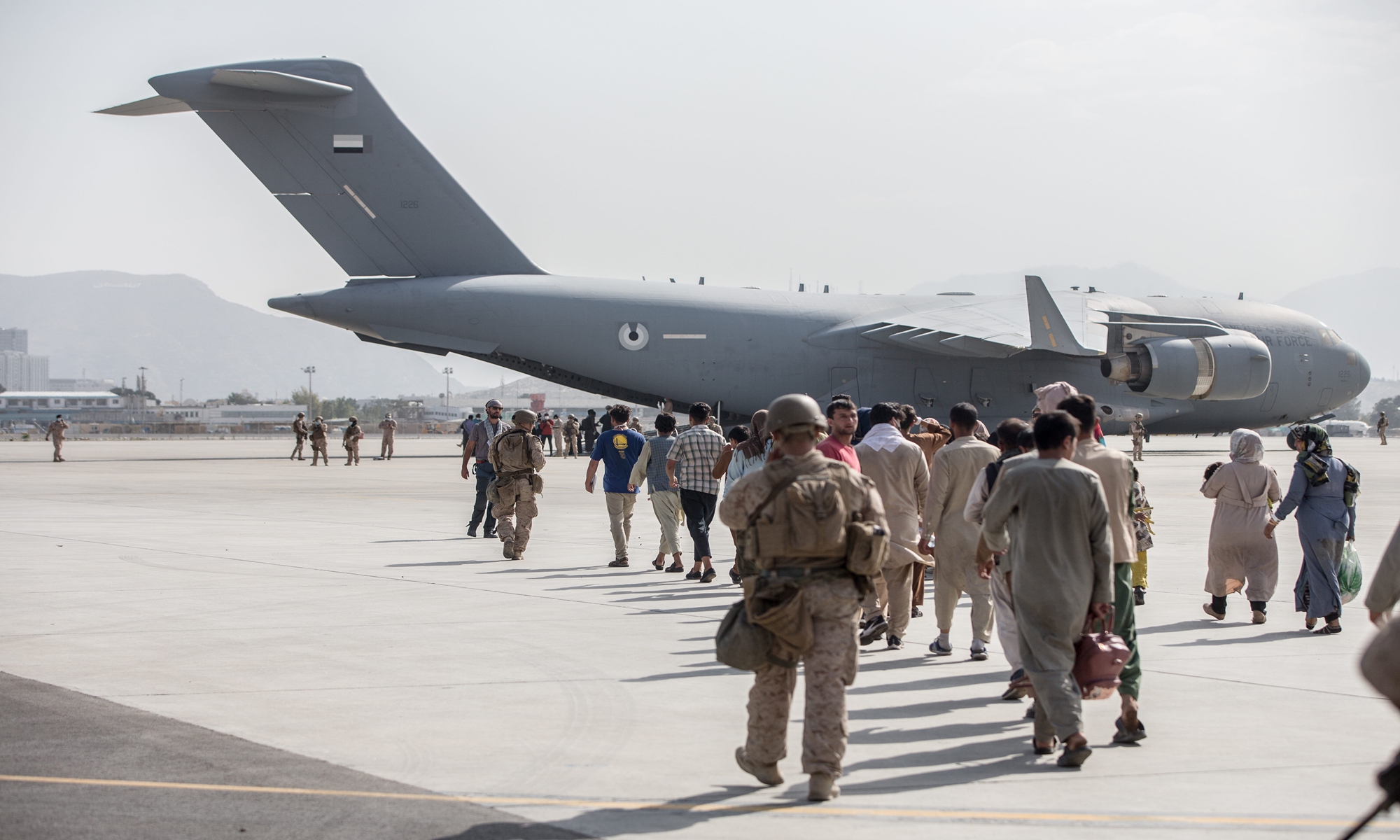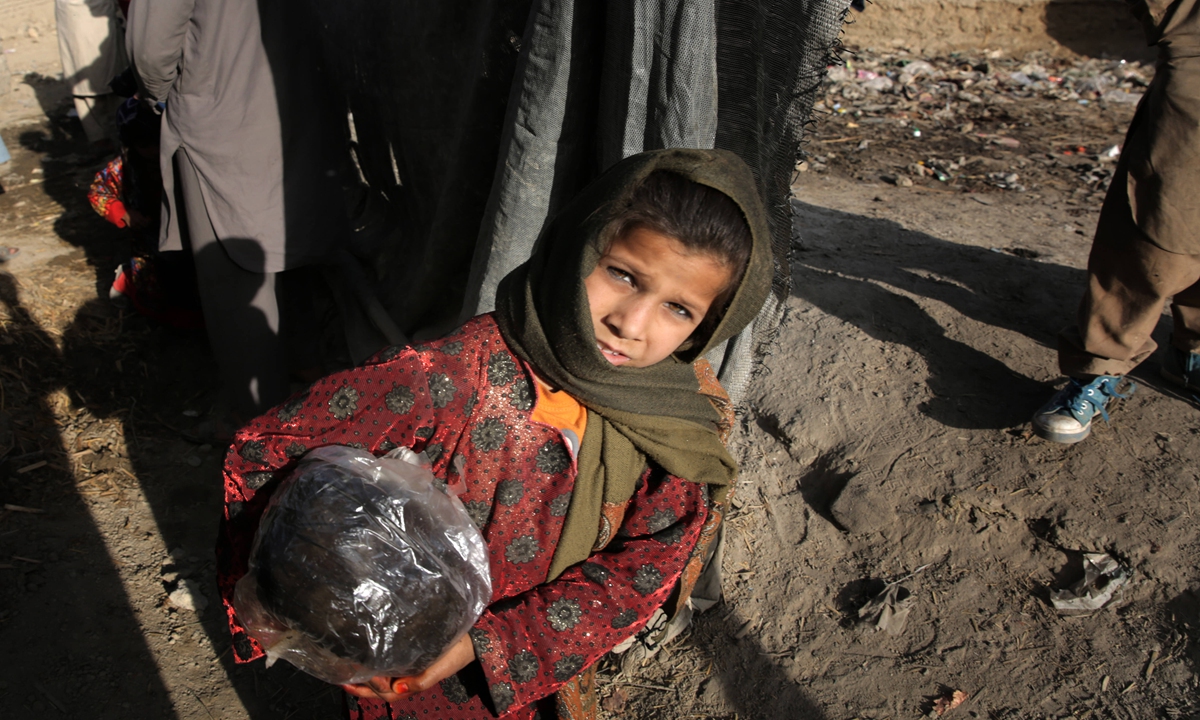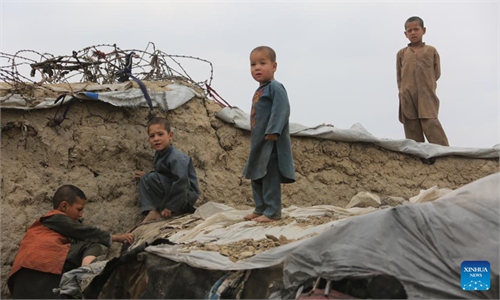IN-DEPTH / IN-DEPTH
Legacy of suffering: Disaster left behind by US leaves Afghans in dire straits, forces many youths to endanger themselves to survive

US service members assist the US Department of State in reducing designated personnel in Afghanistan during an evacuation process, at Hamid Karzai International Airport, Kabul, Afghanistan, on August 21, 2021. Photo: IC
Editor's Note:
In 2001, under the banner of counter-terrorism, the US invaded Afghanistan, initiating a conflict that spanned two decades. Throughout this period, the country was engulfed in conflict, its economy faltered, and its people were displaced.
The withdrawal of US troops left Afghanistan in disarray while American "counter-terrorism" efforts paradoxically fostered an environment conducive to the growth of local terrorist organizations. Furthermore, billions of dollars' worth of military weaponry and equipment, left behind by the US forces, found their way into the hands of these groups, casting a menacing cloud over not only Afghanistan and the Middle East, but the entire world.
Terrorists' 'Las Vegas'
According to reports by CNN and other American media outlets, a report from the US Department of Defense revealed that from 2005 to August 2021, just before the US military's withdrawal from Afghanistan; the US had provided about $18 billion in military equipment aid to Afghanistan's defense and security forces.
At the time of the US military's withdrawal, at least $7 billion-worth of advanced weaponry and equipment was left behind in Afghanistan. The BBC reported a figure for the cost of abandoned weapons as potentially being in the tens of billions of dollars. This equipment included advanced aircraft, missiles, military vehicles, small arms and ammunition, and military communication equipment. The media report also cited a report from the US Department of Defense, which raised the question of why so much equipment was left behind, even when large amounts of advanced weaponry and equipment were being shipped from the US to Afghanistan just before the withdrawal.
Images of Taliban soldiers patrolling in US Humvees, wielding American weapons, and sorting and receiving military supplies left behind by the US at Kabul International Airport have grabbed international attention.
The reports point out that with such a vast amount of lethal weapons left behind in Afghanistan, it is difficult to prevent them from falling into the hands of terrorist organizations, posing a significant security threat domestically and to neighboring countries.
Statistics show that at the beginning of the century when the US had just invaded Afghanistan, there were only a few terrorist organizations. But by the time the US withdrew, the number of terrorist groups in Afghanistan had increased to more than 20.
However, there were US media outlets that later debunked the claim made by the BBC about tens of billions of dollars' worth of weapons being left behind, arguing that the figure refers to the total value of all the military equipment used in Afghanistan.
Regardless of the accuracy of the figure, it's undeniable that a significant amount of valuable American military equipment was left behind in Afghanistan. In response, the US took an extremely irresponsible approach, neither recovering nor destroying these weapons, and didn't take any measures to prevent these deadly weapons from falling into the hands of terrorists through various possible channels.
In addition to the weapons, the US also left behind an estimated 2.6 million refugees in Afghanistan. After years of war, Afghanistan has been plagued with problems, its economy has deteriorated, and its people are living in dire conditions.
Among the Afghan refugees, some were displaced by the war, while many others have fled their homes to avoid starvation, moving to neighboring countries or even further afield to make a living.
Years of war and the refugee crisis have led to a significant decrease in the working-age population in Afghanistan. Those who remain find it hard to find jobs. Afghanistan's underdeveloped economy and fragmented industrial system could hardly support an economic restart.
A former Afghan official even told the New York Times that Afghanistan has now become Las Vegas for terrorists, radicals, and extremists. Terrorists, radicals, and extremists from all over the world are willing to try their luck in this "casino city."
After years of war, it's reported that millions of unexploded landmines and bombs are buried in Afghan territory. Western media outlets have reported that it may take thousands of years to completely clear these explosives.
Today, many scavengers in Afghanistan consider discarded weapons and ammunition, including landmines and bombs, as "treasures," as they look for recyclable metal and rubber in them. These scavengers, who risk their lives to live alongside bombs, have become a unique "bomb disposal squad." They dig up and dismantle the discarded ordnances, and transport the recyclable metal and rubber to steel plants for smelting and repurposing.
The scavengers often search in key military passages around Kabul, the capital of Afghanistan, where a large number of landmines and bombs had been deployed.
There's no doubt that this job is extremely dangerous; those involved pray every day before they go out to "work."
The recycled metal is melted down and made into construction steel by steel plants. However, it's reported that there are always unexploded landmines and hand grenades that aren't thoroughly cleaned. These can mix with other waste materials and cause explosions during processing. In response to this, some insiders said that poverty makes them take risks, and it's always better to work in danger than to be a beggar.

A girl carries garbage in a shantytown on the outskirts of Kabul, Afghanistan, in September, 2021.Photo: IC
Grim future ahead
According to statistics from the UN, more than a year after the withdrawal of the US military from Afghanistan, 24 million of the country's 40 million population are in need of emergency humanitarian assistance.
Moreover, a large number of landmines and abandoned explosives left behind by years of war pose a serious threat to the safety of Afghans, especially children. Statistics from international NGOs showed that during the 20 years of US military occupation of Afghanistan, 26,000 children were killed and 34,000 children were permanently disabled due to injuries. After the withdrawal of US troops, dozens of people have been killed or injured every month by the remaining undetonated bombs or landmines in Afghanistan.
Disease is another major threat to Afghan children. Due to a lack of medical treatment and medicine, many infectious diseases such as cholera, which threaten children's health, had spread widely. Media sources reported that when asked about their future aspirations, most of the children gave heartbreaking answers - most of them said that they want to be doctors when they grow up, so that they and their families do not have to suffer from illnesses.
However, a survey conducted after the war revealed that the overall education level in Afghanistan was less than 40 percent. Many children are out of school and have taken on the burdens of life at an early age.
Child labor has also been a chronic problem in Afghanistan for many years. Child labor in Afghanistan includes some children who are employed to participate in armed conflicts. There are also children who are forced to work in brick and carpet factories under harsh working conditions, with many suffering from respiratory diseases. According to a 2021 US government report, 12 percent of Afghan children between the ages of five and 14 are working. Among children of the same age group, less than 40 percent attend school.
Displaced children are also easy targets for traffickers - some children were trafficked and forced to join terrorist organizations, and even brainwashed to be "human bombs." Girls from poor families are often forced into early marriages and are subjected to sexual exploitation.
'Drug bridge' in Kabul
When the US military withdrew in 2021, Afghanistan had already become a country with booming drug trade where 90 percent of the world's total drug production, processing, and shipping occurred. As a place where the opium poppy is produced, more and more people in the country have become addicted to drug. According to some Western media reports and research conducted by American experts, the US is the driving force behind the drug problem in Afghanistan.
According to media reports, about 10 percent of Afghanistan's population is addicted to drugs with the situation becoming far more serious after the withdrawal of the US military. Afghanistan is now facing economic collapse caused by years of war and international economic sanctions. As many Afghan families struggle to make ends meet, an increasing number of people are turning to drugs as a means of escaping the harsh realities of their lives.
Media sources reported that Kabul is full of drug addicts and from time to time, hundreds of people can be seen gathering in parks, sewers, under bridges, and other places to take drugs. Drug problems are becoming rampant.
The famous Pul-e-Sokhta Bridge in Kabul, also known as the "drug bridge," is littered with trash and is a "paradise" for drug addicts who are seen lingering under the bridge until they inevitably overdose.
The problem of drug production and proliferation in Afghanistan only began to emerge during the wars in recent decades. At the turn of the century, the Afghan government implemented a comprehensive ban on drugs and resumed the cultivation of traditional crops. But the good times didn't last long.
After the US military invaded Afghanistan in 2001, Afghan drug production and trade rebounded immediately. A UN official in Afghanistan has pointed out that the Afghan people have experienced decades of war, poverty, unemployment, and post-war trauma. These factors, combined with easy access to drugs, are the reasons why Afghanistan has a large number of drug addicts.
A Reuters report in 2007 said that Afghanistan was the world's largest producer of opium, accounting for 93 percent of the world's opium supply at the time. However, some Western media reports have shown that the root cause of the drug problem in Afghanistan comes from the US, specifically from the US Central Intelligence Agency's strategy of "fighting with drugs."
Professor Alfred McCoy of the University of Wisconsin-Madison pointed out in his book The Politics of Heroin: CIA Complicity in the Global Drug Trade that during the Soviet-Afghanistan war, resistance groups in Afghanistan began to grow opium poppies and produce and sell drugs with the guidance and assistance of the CIA. Once the Pandora's Box was opened, it quickly got out of control. The Americans' poisonous strategy of "fighting with drugs" has finally harmed Afghanistan, leaving the country and its people in the darkness of drugs.
Many US media outlets have published articles criticizing the US' shameful role in Afghanistan's drug problems. US media outlet MintPress News published an article titled "Geopolitics, profit, and poppies: How the CIA turned Afghanistan into a failed narco-state" in June 2021.
Since the end of World War II, under the banner of "anti-terrorism," "democracy," and "human rights," the US has continuously launched wars, exported turmoil, and interfered in the internal affairs of various sovereign states around the world. After making a mess in other countries, the US just left, regardless of the tragedy left behind. Although wars have never ended, the disaster brought about by the US to these regions, countries, and even the world is far from over. By reviewing the history, it is not difficult to see that the US is far from a reliable ally.


